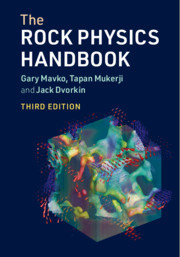Description
The Rock Physics Handbook (3rd Ed., Revised edition)
Authors: Mavko Gary, Mukerji Tapan, Dvorkin Jack
Brings together widely scattered theoretical and laboratory rock physics relations critical for modelling and interpretation of geophysical data.
Language: English
Subject for The Rock Physics Handbook:
Approximative price 95.29 €
In Print (Delivery period: 14 days).
Add to cart
Publication date: 01-2020
756 p. · 17.8x25.2 cm · Hardback
756 p. · 17.8x25.2 cm · Hardback
Description
/li>Contents
/li>Biography
/li>
Responding to the latest developments in rock physics research, this popular reference book has been thoroughly updated while retaining its comprehensive coverage of the fundamental theory, concepts, and laboratory results. It brings together the vast literature from the field to address the relationships between geophysical observations and the underlying physical properties of Earth materials - including water, hydrocarbons, gases, minerals, rocks, ice, magma and methane hydrates. This third edition includes expanded coverage of topics such as effective medium models, viscoelasticity, attenuation, anisotropy, electrical-elastic cross relations, and highlights applications in unconventional reservoirs. Appendices have been enhanced with new materials and properties, while worked examples (supplemented by online datasets and MATLAB® codes) enable readers to implement the workflows and models in practice. This significantly revised edition will continue to be the go-to reference for students and researchers interested in rock physics, near-surface geophysics, seismology, and professionals in the oil and gas industries.
Preface; 1. Basic tools; 2. Elasticity and Hooke's law; 3. Seismic wave propagation; 4. Effective elastic media: bounds and mixing laws; 5. Granular media; 6. Fluid effects on wave propagation; 7. Empirical relations; 8. Flow and diffusion; 9. Electrical properties; Appendices; References; Index.
Gary Mavko is Professor Emeritus at the Department of Geophysics, Stanford University, California. He was awarded Honorary Membership by the Society of Exploration Geophysicists (SEG) in 2001, was named the spring SEG Distinguished Lecturer in 2006, and shared the ENI medal for New Frontiers in Hydrocarbons in 2014. He is also co-author of Quantitative Seismic Interpretation (Cambridge, 2005).
Tapan Mukerji is Professor at the Department of Energy Resources Engineering, Stanford University, California. He received the Society of Exploration Geophysicists (SEG)'s Karcher Award in 2000, and shared the 2014 ENI award for pioneering innovations in theoretical and practical rock physics for seismic reservoir characterisation. He is also co-author of Quantitative Seismic Interpretation (Cambridge, 2005) and Value of Information in the Earth Sciences (Cambridge, 2015).
Jack Dvorkin is Research Fellow and Program leader at King Fahd University of Petroleum and Minerals, Saudi Arabia. He was awarded honorary membership by the Society of Exploration Geophysicists (SEG) in 2014, and shared the 2014 ENI medal for 'New Frontiers in Hydrocarbons'. He is also co-author of Seismic Reflections of Rock Properties (Cambridge, 2014).
Tapan Mukerji is Professor at the Department of Energy Resources Engineering, Stanford University, California. He received the Society of Exploration Geophysicists (SEG)'s Karcher Award in 2000, and shared the 2014 ENI award for pioneering innovations in theoretical and practical rock physics for seismic reservoir characterisation. He is also co-author of Quantitative Seismic Interpretation (Cambridge, 2005) and Value of Information in the Earth Sciences (Cambridge, 2015).
Jack Dvorkin is Research Fellow and Program leader at King Fahd University of Petroleum and Minerals, Saudi Arabia. He was awarded honorary membership by the Society of Exploration Geophysicists (SEG) in 2014, and shared the 2014 ENI medal for 'New Frontiers in Hydrocarbons'. He is also co-author of Seismic Reflections of Rock Properties (Cambridge, 2014).
© 2024 LAVOISIER S.A.S.




